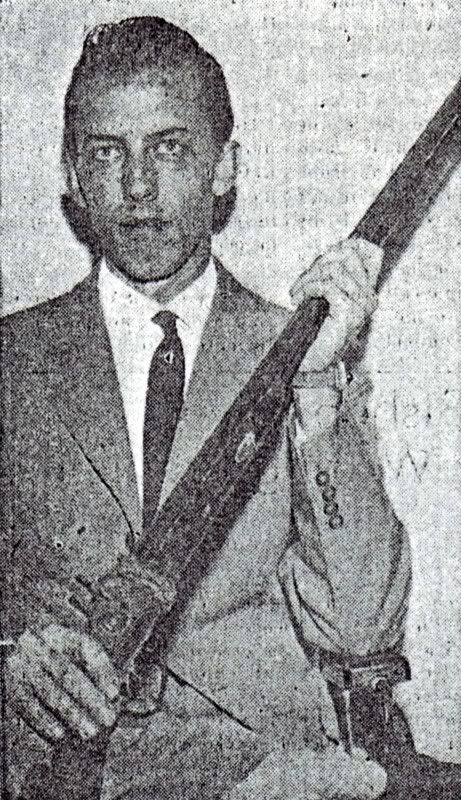The 1884 “Cane Creek Massacre” in Tennessee took the lives of two missionaries, two local members (brothers to each other), and one member of the attacking force. The mother of the two brothers was maimed for life, and proselyting in the immediate neighborhood of the massacre ceased for a period of years.
I have blogged once about this event, and BruceC has blogged a number of times about his recent researches into (for him) local history – he has been uncovering a number of documents – including photographs – in Tennessee sources that have never been used by those writing from the Mormon perspective, and has been exploring the genealogical connections of some of those involved. If the Cane Creek tragedy is of interest to you, or if you’d like to undertake researches into your own local history but aren’t sure how to start, I recommend BruceC’s site (click on the “Cane Creek” label to pull up all his relevant posts).
In addition, an upcoming issue of the Tennessee Historical Quarterly is scheduled to publish “Tennessee’s 1884 ‘Mormon Massacre’ and the Cane Creek Vigilante Movement” by Jeremy R. Ricketts, which looks to be a far more thoroughly researched and contextualized study than has ever before appeared.
My own recent prowling through old Church publications turned up an interesting bit in connection with this 1884 event:
 In May 1944, LDS missionaries Gaell W. Lindstrom and Riego S. Hawkins visited Cane Creek from their home base at Hohenwald, only three miles away. They called on friends living at Cane Creek, including the Talley family whose father had hosted the elders in 1884 and aided the missionaries and Conder family after the massacre. They visited the tiny, overgrown cemetery next to the site of the Conder home (no longer standing in 1944), where they photographed the stone standing on the brothers’ grave, with its “Greater Love Hath No Man” inscription. That cemetery had also been the resting place of the two murdered elders for a few days, before B.H. Roberts had retrieved their bodies and returned them to Utah.
In May 1944, LDS missionaries Gaell W. Lindstrom and Riego S. Hawkins visited Cane Creek from their home base at Hohenwald, only three miles away. They called on friends living at Cane Creek, including the Talley family whose father had hosted the elders in 1884 and aided the missionaries and Conder family after the massacre. They visited the tiny, overgrown cemetery next to the site of the Conder home (no longer standing in 1944), where they photographed the stone standing on the brothers’ grave, with its “Greater Love Hath No Man” inscription. That cemetery had also been the resting place of the two murdered elders for a few days, before B.H. Roberts had retrieved their bodies and returned them to Utah.
 Following their cemetery visit, the two elders drove on to Trace Creek, about six miles away, to call on Rachel Conder and Lavicia Conder Haley, sisters of the murdered brothers, who had been present at the slaughter during the 1884 church services. These elderly women, still members of the Church, welcomed the elders and rehearsed for them their memories of that day. One of them brought out a relic of that day – the double-barrelled, breech-loading shotgun used by their brother John Riley Hudson in defense of Elders Gibbs and Berry and the others present in the Conder home.
Following their cemetery visit, the two elders drove on to Trace Creek, about six miles away, to call on Rachel Conder and Lavicia Conder Haley, sisters of the murdered brothers, who had been present at the slaughter during the 1884 church services. These elderly women, still members of the Church, welcomed the elders and rehearsed for them their memories of that day. One of them brought out a relic of that day – the double-barrelled, breech-loading shotgun used by their brother John Riley Hudson in defense of Elders Gibbs and Berry and the others present in the Conder home.
Elder Hawkins asked the sisters if they might be willing to donate that shotgun to the church museum in Salt Lake City, where it would be preserved and its identity remembered. The sisters told him that an earlier missionary had made the same request, but that they hadn’t been ready at that time to part with the gun. After a few minutes discussion between themselves, the women agreed to send the gun to Salt Lake, in the care of Elder Lindstrom who would be returning home in a few weeks.
 So in July 1944, Elder Lindstrom returned to Salt Lake to report his mission, walking into his appointment at church headquarters carrying the antique firearm. He posed for his picture holding the relic, which the First Presidency directed be turned over to the museum on Temple Square.
So in July 1944, Elder Lindstrom returned to Salt Lake to report his mission, walking into his appointment at church headquarters carrying the antique firearm. He posed for his picture holding the relic, which the First Presidency directed be turned over to the museum on Temple Square.
The gun is still owned by the Church. It is in fair shape with both repaired and unrepaired damage. The barrels are engraved, with elephants (!), and a hunting scene of trees, rail fence, and birds in flight. The maker’s mark is unfortunately illegible.
The museum cataloging includes a brief summary of the Cane Creek massacre, where John Riley Hudson, Malinda Conder’s oldest son, was mistakenly described as “a non-member who lived with the Condors.” That error was quickly corrected by an archivist when I pointed it out – the young man gave his life in defense of the missionaries; his own membership shouldn’t be forgotten!
Continue reading at the original source →



